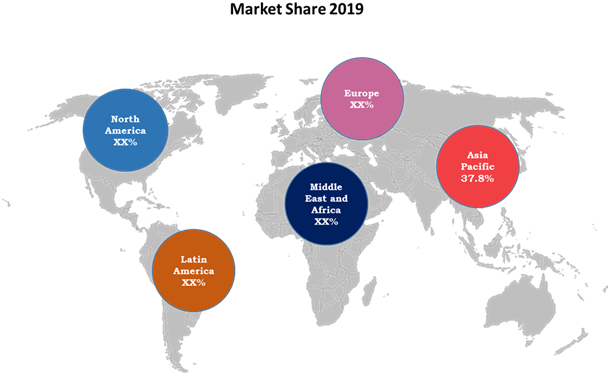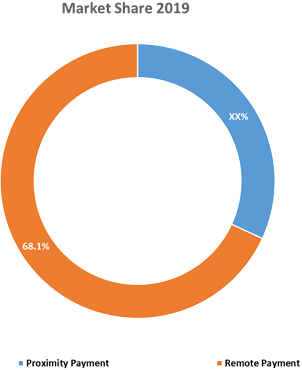Market Overview
Mobile payment is the payment method where a portable electronic device namely smartphones are employed as payment vehicles. This technology enables consumers to make immediate payments for services and products. The primary objective behind mobile payment technology is to avoid usage of currency, paper, coin, and plastic media such as debit/credit cards, checks, and paychecks. Both developed and emerging economies have started adopting mobile payment technologies rapidly, owing to rising evolution of fast speed internet and increasing penetration of smartphones. The global mobile payment technologies market is expected to witness substantial revenue expansion from 2016 onwards, and register a robust CAGR rate till 2020, owing to the advent of ground-breaking payment solutions to provide immediate payments through mobile phones and subsequent reluctance from end-users for its adoption/implementation.
The global mobile payment technologies is estimated to account for US$ 664.19 Bn in 2019 and is expected to grow at a CAGR of 21.3% over the forecasted period 2019-27.
Market Dynamics- Drivers
Adoption of smart appliances along with the use of mobile data has increased significantly in the recent past. This is owing to the ease of communication and increasing demand for convenient transactions by consumers across the globe. Smart appliances such as tablets and smartphones with related applications are necessary gadgets required for mobile payment technology. It thereby allows payment without using conventional financial transaction channels. According to the Groupe Speciale Mobile Association (GSMA) Mobile Economy Report 2016, the penetration rate of smartphones is expected to rise from 63% in 2015 to 72% in 2020. It is expected that smartphones would play an increasingly important role in the payments space over the next few years. According to the same source, around 2.5 billion individuals across emerging economies were accessing the internet through mobile devices until 2015. Thus, mobile data usage penetration is expected to rise from 23% in 2015 to 37% in 2020. Hence, these factors are expected to drive growth of the market during the forecast period.
Rapid development in payment technology has changed consumer and business expectations for payment systems globally. The adoption of advanced technologies such as near-field communication, wearable devices, and mobile point-of-sale are expected to lift the demand for mobile payment technologies in the near future. According to the Payments U.K. Report 2015, electronic payments transactions migrate toward mobile payments due to the growing adoption of smartphones and tablets among end-users. Therefore, mobile payments are anticipated to rise annually by 60.8% from 2015, whereas electronic payments’ growth will slow down to annual growth of 15.9% during the forecast period. Moreover, governments and federal banks are focused on developing centralized payment systems, in order to achieve a cashless economy and consistent levels of security worldwide. For instance, the Reserve Bank of India is planning to develop a centralized payment system. In order to accomplish this, it has taken several initiatives for secure, accessible, sound, safe, efficient, and authorized payment methods in the country.
APAC region dominated the global mobile payment technologies market in 2019, accounting for 37.8% share in terms of value, followed by MEA, North America, Europe and South America respectively.

To learn more about this report, Download Free Sample
Source: Coherent Market Insights
Market Dynamics- Restraints
Consumer preference is one of the major factors restricting the market growth, typically due to a lack of awareness of specific mobile payment services and features available for particular smartphones. Apart from these factors, consumers are concerned about the security and privacy of mobile wallets due to increasing incidents of cyber-attacks on financial information. According to Coherent Market Insights’ analysis, in North America, 52% of consumers are extremely aware of mobile payment technologies. Despite this awareness, only 18% of them make payments through mobile technologies across the region.
Technical difficulties such as network issues or connection failure, power failures, especially in emerging economies such as Africa and Latin America are major factors hindering growth of the market. Thus, consumers from these regions seldom prefer mobile payment technologies and adopt cash or paychecks for payments. Thus, these factors are expected to restrain growth of the global mobile payment technologies market in the near future.
Market Opportunities
Internet of Things (IoT) is an evolving technology that helps to send and receive data from Internet-enabled devices. Integration of IoT with payment applications provides a major opportunity for the extension of payment solution offerings and development of robust payment technologies. Moreover, IoT-powered devices can offer secure payments and promise greater convenience for recipients and also for customers.
Governments are taking proactive initiatives to support digital payment, in order to accomplish goal of a cashless economy. For which, the governments are making necessary regulatory framework changes by providing tax incentives and adopting social-transfer digital payments. Many countries, such as Finland, Italy, and the Netherlands, are planning to implement a national instant payment scheme to replace traditional payment systems. Moreover, the Indian government has taken several initiatives to promote digital innovation and financial inclusion.

To learn more about this report, Download Free Sample
Source: Coherent Market Insights
Market Trends
Rising adoption of mobile payment technology for easy monetary transactions
Mobile payment technologies are being adopted rapidly in North America, particularly in Canada and the U.S. This is owing availability of easier, more secure, and convenient mobile transactions through mobile payment technologies. The U.S. mobile payment technologies market is in its nascent stage and has gained significant traction after the launch of Apple Pay in October 2014.
Strict regulatory policies are supporting mobile payment technology systems
Various governments across the region have enforced strict regulatory policies, in order to support the development of payment technology and making a cashless economy. Thus, Europe holds a positive outlook for mobile payment technologies market in the near future. For instance, policies such as the European Central Bank’s Single European Payments Area (SEPA), are designed to complement the domestic and cross-border cashless payments. Though the implementation of the policy faces stiff challenges due to factors such as demographics/nature of the countries and regional government rules and banking regulations, it is essential for the efficient growth of the wholesale and global mobile payment technologies market.
Segment information:
In global mobile payment technologies market, by type segment remote payment sub-segment dominated the global mobile payment technologies market in 2019, accounting for 68.1% share in terms of value, followed by Proximity Payment.

To learn more about this report, Download Free Sample
Source: Coherent Market Insights
Competitive Section
Key players operating in the global mobile payment technologies market are PayPal, Inc., Microsoft Corporation, MasterCard International Inc., Apple, Inc., American Express, Co., Google, Inc., Boku, Inc., AT & T, Inc., Visa, Inc., Vodafone Ltd., State Bank of India (SBI), Fortumo, and Bharti Airtel Ltd.
Key Developments
Share
Share
Missing comfort of reading report in your local language? Find your preferred language :
Transform your Strategy with Exclusive Trending Reports :
Frequently Asked Questions
Select a License Type
Joining thousands of companies around the world committed to making the Excellent Business Solutions.
View All Our Clients